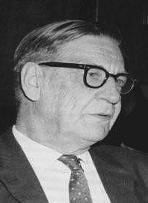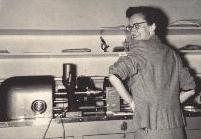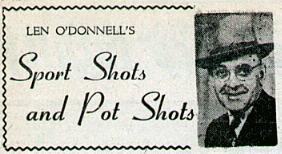Those were the days: people and activities

Hauling up proofs in tin buckets
The Record's proofreaders in 1953 were, right, GWEN BELLAM and MRS. GLADYS BROWNLOW, affectionately known as "Mrs. B," who had joined the paper in 1946. These two were all that stood between a flood of typographical errors and the newspaper reader. They worked on the second floor of the downtown Wellington St. building adjoining the editorial department. The mechanical department (we called it the "backshop") was on the ground floor at the rear of the building. Getting galley proofs up to the proofreaders, and sending the corrected proofs back was done by means of a tiny elevator shaft.
It was outfitted with a hand-operated "dumb waiter," two rectangular tin buckets connected by a long rope that ran up over a pulley at the top of the shaft. A household electric doorbell at the top of the shaft let the proofreaders know there was a shipment of proofs to be read. There was another at the bottom of the shaft, which came down behind the desk of backshop superintendent FRANK KENALTY. Usually, the proofreaders just shouted down the shaft to let him know corrected proofs were on the way. It all worked well enough most of the time, but unfortunately, rats liked to nest in the bottom of the shaft. Periodically, rat exterminators had to be called to keep the numbers down.
And every once in a while, a rat or two died, trapped somewhere down there. The stench went through the whole building!
The mechanical department (we called it the "backshop") was on the ground floor at the rear of the building. Getting galley proofs up to the proofreaders, and sending the corrected proofs back was done by means of a tiny elevator shaft.
It was outfitted with a hand-operated "dumb waiter," two rectangular tin buckets connected by a long rope that ran up over a pulley at the top of the shaft. A household electric doorbell at the top of the shaft let the proofreaders know there was a shipment of proofs to be read. There was another at the bottom of the shaft, which came down behind the desk of backshop superintendent FRANK KENALTY. Usually, the proofreaders just shouted down the shaft to let him know corrected proofs were on the way. It all worked well enough most of the time, but unfortunately, rats liked to nest in the bottom of the shaft. Periodically, rat exterminators had to be called to keep the numbers down.
And every once in a while, a rat or two died, trapped somewhere down there. The stench went through the whole building!
Reporting on the 1953 federal election in an era before TV
On Aug. 10, 1953, the Louis St. Laurent Liberals won another federal election. Election night was a hectic one at the Record. Television was only a year old in Canada, and newspapers were still the main source of up-to-the minute election returns, so they put on their own kind of "show."At the Record, progressive results were posted on hand-numbered pieces of cardboard pinned to huge election boards in the paper's street-level front windows, which were like store windows. Large crowds gathered on Wellington Street to watch as the returns were posted. My job that night was running the results cards from the upstairs newsroom down to the election boards. The numbers were supplied by the Canadian Press wire service over teletype machines. Squads of Record staffers transcribed the numbers onto the cards with thick marker pens .
When the election outcome was known, the winning Sherbrooke MP, Liberal Maurice Gingues, came to the Record to give a victory speech. He stooped through an open window in the second-floor newsroom out onto the top of the flat canopy over the building's entrance. Lights and a microphone had been set up there, and the crowd stood on the sidewalks and overflowed into the street to hear his words.

High tech: engraving on blue plastic
New technology arrived in 1954 for turning glossy photos into engravings that could be printed, and BARBARA WARK, at right, was its keeper. It was a machine that scanned a picture and produced a half-tone micro-dot engraving on a pliable blue plastic plate. Double-backed tape was applied to the back of the plate, and it was ready to be stuck in place on the big lead cylinders that went on the old rotary press to print the paper. We called the machine "The Fairchild" after the company that made it. The machine was a lot faster and cheaper than the old method, which involved heavy zinc plates. For a long time, the Fairchild was set up in the editor's office, right behind his desk. It made a loud buzzing noise and also generated a burnt plastic odour, both of which seeped out to the newsroom.
Down to the LaSalle after work for some beer and darts
 In late 1950's and the early years of the 1960's, the favorite watering hole for editorial types was the Ballerina Lounge of the LaSalle Hotel, downtown on King St. West. After work, I and a bunch of others from the newsroom and other departments would go there for a few rounds of beer, then move to the basement darts room for several games.
Many games, actually! We drank beer by the quart bottle, that being the way bottled beer was sold in those days. Some of us became fairly expert darts players, though I could seldom beat news editor, GERRY McDUFF, on left. A couple of Record staffers achieved some local fame with their bar-room tricks. One, JIM WILLIAMS, bit off chunks of a beer glass with his teeth and slowly chewed and swallowed the pieces. Another, reporter PAUL WATERS, pried caps off beer bottles with his teeth, no mean feat in the days before twist-tops.
In late 1950's and the early years of the 1960's, the favorite watering hole for editorial types was the Ballerina Lounge of the LaSalle Hotel, downtown on King St. West. After work, I and a bunch of others from the newsroom and other departments would go there for a few rounds of beer, then move to the basement darts room for several games.
Many games, actually! We drank beer by the quart bottle, that being the way bottled beer was sold in those days. Some of us became fairly expert darts players, though I could seldom beat news editor, GERRY McDUFF, on left. A couple of Record staffers achieved some local fame with their bar-room tricks. One, JIM WILLIAMS, bit off chunks of a beer glass with his teeth and slowly chewed and swallowed the pieces. Another, reporter PAUL WATERS, pried caps off beer bottles with his teeth, no mean feat in the days before twist-tops.

Piles and piles of country correspondence
FRANCES "FANNIE" WILLIAMS started working at the Record in 1920. During the whole of the time I was there, she was in charge of country correspondence. The paper ran huge volumes of this material, everything from social notes to group meetings from every community, large and small. Fannie edited all this material at her desk piled high with contributions, most of which arrived hand-written on sheets of unlined newsprint copy paper. There were over 100 country correspondents through the 1950's, and Fannie dealt with them all, making sure they were supplied with paper, and that they were paid. Rates of payment varied widely. Correspondents in the smaller communities got a free Record subscription. Others got paid space rates, anywhere from a few cents per column-inch as published, up to ten cents an inch in major communities. Fannie kept track of all this. For paid correspondents, she measured their column-inches with a ruler, and passed on totals to the business office for payment. Fannie was still doing this when I left the Record in 1968, though by then we had cut down the number of correspondents by about half.
Visiting the correspondents: tea and cookies in the parlor
In the early 1960's, I did a tour of the Record's circulation area to meet some of our country correspondents in the smaller communities. Most of them (but not all) were housewives recording the social comings and goings that were the rhythm of rural life. Many lived on farms; some had been correspondents for years, and their mothers before them. A visit from the editor of the Record, I discovered, was a major event. None of the correspondents I met had ever received such a visit before. One long-time correspondent organized an afternoon tea party in her parlor in my honour. She and her guests plied me with tea and home-made cookies and questions about how a newspaper operated. And as I left, they presented me with a piece of hand-crafted Eastern Townships glazed pottery in the shape of a tortoise.
 Probably the most prolific country correspondent was IVY HATCH of Stanstead, who covered her town and the entire area around it on the border with Vermont. She didn't just write social notes, but also covered fires, accidents and other real news events, and did it just as well as our staff reporters. Ivy first began as a correspondent in 1946, and kept at it for 53 years. That's Ivy there on the right, in retirement at 91, as she looked in the spring of 2004. The picture was taken by freelance photojournalist GORDON ALEXANDER, himself once a member of the Record's advertising department.
Probably the most prolific country correspondent was IVY HATCH of Stanstead, who covered her town and the entire area around it on the border with Vermont. She didn't just write social notes, but also covered fires, accidents and other real news events, and did it just as well as our staff reporters. Ivy first began as a correspondent in 1946, and kept at it for 53 years. That's Ivy there on the right, in retirement at 91, as she looked in the spring of 2004. The picture was taken by freelance photojournalist GORDON ALEXANDER, himself once a member of the Record's advertising department.
One-man sports department covered everything that moved
 Cigar-smoking sports editor LEONARD "LEN" O'DONNELL joined the Record in 1946. He was Sherbrooke's dean of sports writers and the paper's one-man sports department during the years I was with the paper. A bilingual and prominent member of Sherbrooke's large Irish-Canadian community, he covered major sports, recruited correspondents, edited and made up the paper's sports pages six days a week, and wrote his regular column, Sport Shots and Pot Shots. Len's workdays were often long ones; he was at his desk very early every morning to take care of the sports pages, and usually had an event to cover at night. He kept going on weekends, too, when sports are at their busiest. In the four years I was at nearby Bishop's University, I covered university sports for him, and was paid 10 cents a column inch. A former hockey player and referee, Len was involved in a number of community sports organizations. He played an expert game of golf, too, mostly at the Sherbrooke Country Club. Len was still the sports department of the Record when I left in 1968.
Cigar-smoking sports editor LEONARD "LEN" O'DONNELL joined the Record in 1946. He was Sherbrooke's dean of sports writers and the paper's one-man sports department during the years I was with the paper. A bilingual and prominent member of Sherbrooke's large Irish-Canadian community, he covered major sports, recruited correspondents, edited and made up the paper's sports pages six days a week, and wrote his regular column, Sport Shots and Pot Shots. Len's workdays were often long ones; he was at his desk very early every morning to take care of the sports pages, and usually had an event to cover at night. He kept going on weekends, too, when sports are at their busiest. In the four years I was at nearby Bishop's University, I covered university sports for him, and was paid 10 cents a column inch. A former hockey player and referee, Len was involved in a number of community sports organizations. He played an expert game of golf, too, mostly at the Sherbrooke Country Club. Len was still the sports department of the Record when I left in 1968.
Photographers, parties, summer visits from the boss, etc.
GERRY LEMAY STUDIO was the Record's main photo service in the 1950's and 60's. The principal photographer was first, ROYAL ROY, until he was hired away by Sherbrooke's much bigger French-language daily, La Tribune, and then STAN LOUGHHEED. The studio's owner, GERRY, occasionally took pictures, too, and his wife, VERA, often did. In the early 60's, another photo service was established in the city by DOUG GERRISH, and he also became a Record regular. Reporters did not make enough money to own cars, and so most travelling was done in photographers' cars. Several out-of-town freelance photographers were also used. The most prolific was probably BILL LUNAN, who covered the Asbestos-Richmond area. In 1968, when the Record converted to the offset printing process, reporters were equipped with POLAROIDS and took some of their own pictures. A Christmas party, right, in ye olde editor's basement rec room, in 1966 or 1967. Some of the newsroom people who were there posed for this picture. From the left:
FANNIE WILLIAMS, country correspondence editor; DOUG GERRISH,
photographer; MR. WILLARD, husband of the women's editor; DENNIS FINLAY, reporter; MRS. GWEN WILLARD, women's editor; DICK NUTBROWN, reporter, and at bottom right is CLAUDE ADAMS, reporter. There were no cash Christmas bonuses at the Record. Instead, the company gave everyone a turkey, a tradition that had been going for a long time when I first started at the newspaper in 1953, and was still going on in 1968.
A Christmas party, right, in ye olde editor's basement rec room, in 1966 or 1967. Some of the newsroom people who were there posed for this picture. From the left:
FANNIE WILLIAMS, country correspondence editor; DOUG GERRISH,
photographer; MR. WILLARD, husband of the women's editor; DENNIS FINLAY, reporter; MRS. GWEN WILLARD, women's editor; DICK NUTBROWN, reporter, and at bottom right is CLAUDE ADAMS, reporter. There were no cash Christmas bonuses at the Record. Instead, the company gave everyone a turkey, a tradition that had been going for a long time when I first started at the newspaper in 1953, and was still going on in 1968.
Home Page | History of The Record | Covering the County Fairs
Glenn Gould Comes to Town | The Editors | Learning on the Job
A First in Canada | The Strike of '62 | 60th Anniversary in 1957
Trudeaumania Hits the City | Montreal's Expo 67 | Nightstaff: a poem
Memorable Headlines
Comments? Click here to E-mail author Hugh Doherty
Page created Spring 1999. Last updated Mar. 4, 2012